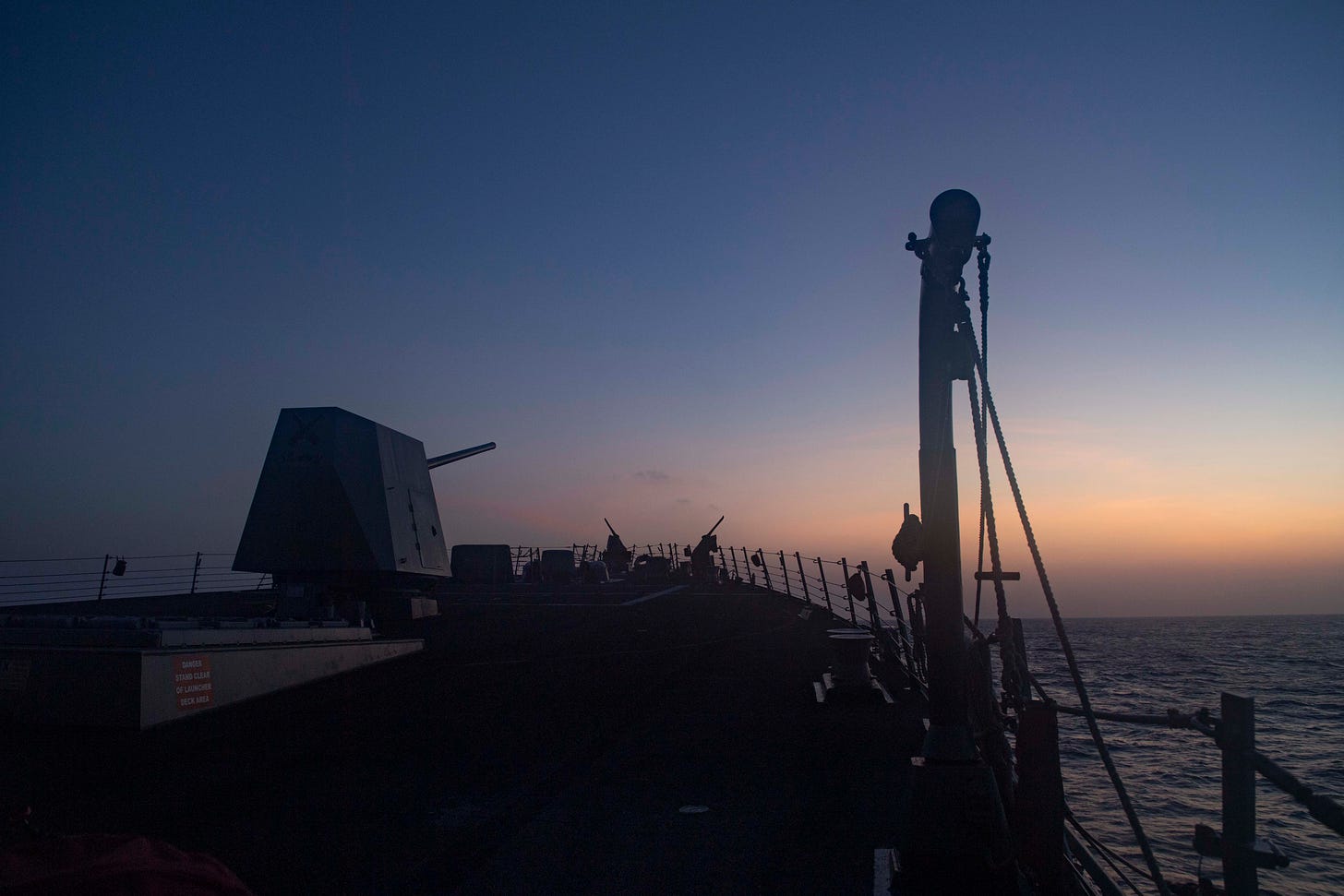Ten Months of Lessons from the Red Sea, with Bryan McGrath, on Midrats
...the demigods of the maritime copybook headings...
If you find a message that is consistent over time, through times of ease and times of challenge, and at each challenge in the real world this message is validated, reinforced, and found to be correct — is that a message you need to pay attention to?
Since the Houthi joined a second front with the Gazans against Israel by attacking international shipping in the Red Sea and its approaches, the US Navy has led the international response and has been engaged in continuous combat operations facing almost all anti-ship weapons that any navy would expect to face in 2024.
The experience in the Red Sea is validating the consistent messages about fleet size and requirements voiced by our guest this week on Midrats — a consistent guest since 2010 — Bryan McGrath, Commander, USN (Ret.).
You can listen here, or on Spotify below.
Showlinks:
The Navy is too Damn Small: Bryan McGrath on Substsack
The Law the Department of Defense Loves to Break: Madeline Zimmerman
Buy Fords, not Ferraris: Jerry Hendrix
Summary
In this conversation, Sal, Mark, and Bryan McGrath discuss the ongoing attacks on international shipping in the Red Sea by the Houthis, who are clients of Iran. They also talk about the performance of the US Navy in protecting commercial shipping, the investments made in the Navy, and improvements and challenges in the US Navy. The conversation then shifts to the development of directed energy weapons and the challenges in integrating them into the fleet. They also discuss the importance of multi-mission platforms and the need for single-mission platforms in certain situations. The conversation concludes with a discussion on the presence and deterrence mission of submarines and the need for VLS reload capabilities on DDGs. McGrath highlighted the positive changes in the fleet's material condition and combat systems, as well as the increased investment in training and spare parts. However, he also expressed concerns about the extended deployments and the strain it puts on ships and crews. McGrath emphasized the need for a larger Navy, particularly in terms of aircraft carriers, to meet the demands of global operations. He also discussed the challenges in the shipbuilding industry and the importance of stability and additional shipyards.
Sound Bites
"It is time to bring systems to see that allow us to economically engage civilizations that can out-produce us"
"There's been three straight budgets now that have funded spare parts significantly higher than I have seen them since I was in command."
Chapters
00:00: Introduction
02:04: Ongoing Attacks on International Shipping in the Red Sea
04:07: Performance of the Fleet in the Red Sea
07:10: The Potential of Directed Energy Weapons
09:40: Challenges in Integrating New Technology
12:14: The Need for More VLS Tubes and Single-Mission Platforms
16:13: The Role of Submarines in Naval Power
21:53: Deterrence in the South China Sea
26:43: Presence and Deterrence with the USS Georgia
30:20: Rearming DDGs and the Importance of VLS
33:36: Improvements in Shipyards and Material Conditions
41:18: The Need for More Aircraft Carriers
48:00: The Impact of Extended Deployments
54:35: The Importance of Spare Parts
58:58: Challenges of the Constellation Class
01:00:09: The Importance of Stability and Additional Shipyards
Bryan is the founding Managing Director of The FerryBridge Group LLC (FBG), a niche consultancy specializing in naval and national security issues including national and military strategy, strategic planning, executive communications, strategic communications, and emerging technologies.
A retired Naval Officer, Bryan spent 21 years on active duty including a tour in command of USS BULKELEY (DDG 84), a guided-missile destroyer homeported in Norfolk, Virginia. In command, he received the “Admiral Elmo Zumwalt Award for Inspirational Leadership” from the Surface Navy Association and his ship earned the USS ARIZONA Memorial Trophy signifying its selection as the Fleet’s most combat-ready warship. His final duties ashore included serving as Team Lead and Primary Author of the US Navy’s 2007 Maritime Strategy “A Cooperative Strategy for 21st Century Seapower”.
Bryan was formerly the Deputy Director of the Hudson Institute Center for American Seapower. In this capacity, he helped develop the Surface Navy’s “Distributed Lethality” concept and the Center for Strategic and Budgetary Assessments’ 2017 Navy Alternate Fleet Architecture Study.
He served as the Co-Lead of the 2012 Romney for President Naval Policy Committee, and the Lead of the 2016 Rubio for President Navy and Marine Corps Policy Committee. In March of 2023, he was appointed by the Chairman of the House Armed Services Committee (HASC Rep. Mike Rogers R-Al) to the National Commission on the Future of the Navy.
Bryan earned a BA in History from the University of Virginia in 1987, and an MA in Political Science (Congressional Studies) from The Catholic University of America. He is a graduate of the Naval War College.





Low tech and low speed targets and the platforms used 5" almost none is a problem. This was a laboratory made for that gun . . . and they missed it. Those targets were made for that gun if you were close enough.
TORCH OUT
The message I've found in the Houthi attacks is that LNG tankers are EXTREMELY vulnerable to even the smallest of drones. A shipment of coal, on the other hand is just a can of rocks with a motor on the end. Nuclear fuel for a year and a half can be delivered by one C-5A per reactor. Oil tankers at least have double hulls.
No owner of an LNG tanker will sail anywhere near a zone of disorder, much less through a war zone.
That has huge implications for the energy security of countries like Taiwan or the Philippines that want to move to LNG for electric fuel but could be subjected to a Chinese blockage like the recent "War of the Fishes" exercise around Taiwan.
The loss of orderly and safe sea lanes has huge secondary affects.